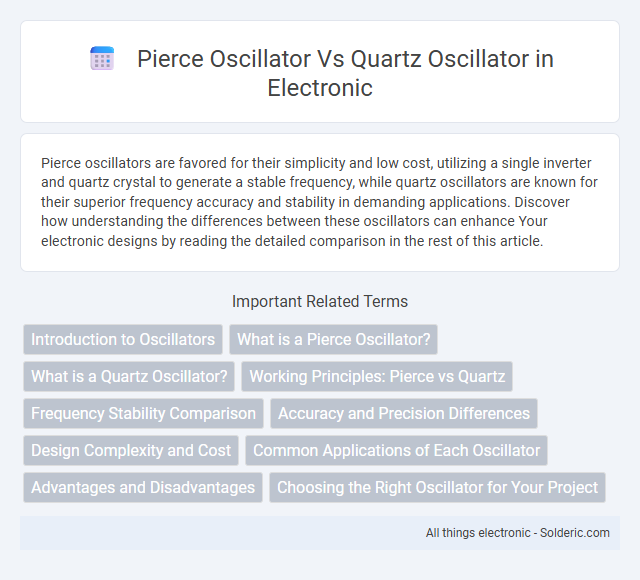Pierce oscillators are favored for their simplicity and low cost, utilizing a single inverter and quartz crystal to generate a stable frequency, while quartz oscillators are known for their superior frequency accuracy and stability in demanding applications. Discover how understanding the differences between these oscillators can enhance Your electronic designs by reading the detailed comparison in the rest of this article.
Comparison Table
| Feature | Pierce Oscillator | Quartz Oscillator |
|---|---|---|
| Oscillation Type | Crystal-controlled, uses inverter and crystal | Uses quartz crystal for stable frequency |
| Frequency Stability | Moderate, depends on crystal and circuit | Very high, due to quartz crystal properties |
| Frequency Range | Typically low to mid RF range | Wide range, from kHz to MHz |
| Complexity | Simple circuit, few components | Can be complex with additional components |
| Power Consumption | Low | Low to moderate depending on design |
| Application | Clocks, microcontrollers, digital circuits | Precision timing, communication systems |
| Cost | Low | Higher due to precision components |
Introduction to Oscillators
Pierce oscillators utilize a crystal, typically quartz, with an inverter and capacitors to generate a stable frequency signal through feedback, making them ideal for compact, low-power applications. Quartz oscillators leverage the precise mechanical resonance of quartz crystal to produce highly accurate and stable frequency outputs essential for timekeeping and communication devices. Your choice depends on the required frequency stability, power consumption, and circuit complexity, with Pierce oscillators often preferred for simplicity and quartz oscillators for precision.
What is a Pierce Oscillator?
A Pierce oscillator is a type of crystal oscillator circuit that uses a quartz crystal to stabilize the frequency of oscillation, providing high precision and stability in electronic devices. Unlike general quartz oscillators, the Pierce configuration typically employs a single inverter and capacitors to create a feedback loop, resulting in lower component count and power consumption. Your choice of a Pierce oscillator is ideal for low-power applications where compact design and accurate frequency control are critical.
What is a Quartz Oscillator?
A Quartz oscillator uses the piezoelectric properties of quartz crystal to generate precise and stable frequency signals, essential for timing applications in electronics. It relies on the consistent mechanical resonance of the crystal, which converts electrical energy into mechanical vibrations and back, producing highly accurate oscillations. These oscillators are preferred in devices like watches, radios, and communication systems due to their exceptional frequency stability and low phase noise compared to other types.
Working Principles: Pierce vs Quartz
Pierce oscillators use a single quartz crystal in a feedback loop with an amplifier to sustain oscillations by taking advantage of the crystal's piezoelectric properties, creating a stable frequency output. Quartz oscillators operate on the same piezoelectric effect but can include more complex circuit configurations like overtone modes or multiple crystals for enhanced frequency accuracy and stability. Understanding these working principles helps you choose the right oscillator for applications requiring precise timing and low phase noise.
Frequency Stability Comparison
Pierce oscillators offer moderate frequency stability, primarily influenced by the characteristics of the crystal and the circuit design, making them suitable for general-purpose applications. Quartz oscillators, especially those with temperature-compensated or oven-controlled designs, provide superior frequency stability over a wide temperature range, achieving variations as low as a few parts per billion. For applications requiring high precision and minimal frequency drift, your choice should lean towards quartz oscillators due to their enhanced stability and reduced sensitivity to environmental changes.
Accuracy and Precision Differences
Pierce oscillators typically exhibit moderate frequency stability with accuracy ranging around +-50 ppm, making them suitable for general timing applications. Quartz oscillators achieve higher accuracy and precision, often within +-0.001 ppm due to the piezoelectric crystal's stable resonant frequency. This fundamental difference makes quartz oscillators ideal for applications requiring tight frequency tolerance and minimal drift over time and temperature variations.
Design Complexity and Cost
Pierce oscillators feature a simpler design with fewer components, making them more cost-effective for low-frequency applications. Quartz oscillators, although more complex due to additional circuitry for precise frequency stabilization, provide superior accuracy and long-term stability. The increased design complexity of quartz oscillators results in higher manufacturing costs but greater reliability in high-frequency and critical timing devices.
Common Applications of Each Oscillator
Pierce oscillators are commonly used in microcontroller clock circuits and low-frequency timing applications due to their simplicity and low component count. Quartz oscillators dominate high-precision applications such as communication systems, GPS devices, and medical instruments because of their superior frequency stability and accuracy. Your choice between Pierce and quartz oscillators depends on the balance needed between performance requirements and circuit complexity.
Advantages and Disadvantages
Pierce oscillators offer simplicity, low component count, and ease of integration with digital circuits, making them cost-effective and reliable for moderate frequency stability applications. Quartz oscillators provide superior frequency accuracy, stability, and low phase noise due to the piezoelectric properties of quartz crystals, ideal for precision timing and communication systems. However, Pierce oscillators suffer from lower frequency stability and higher susceptibility to temperature variations, while quartz oscillators are more complex, bulky, and expensive to manufacture.
Choosing the Right Oscillator for Your Project
Pierce oscillators are ideal for low-power, cost-sensitive applications due to their simple circuit design and reliable startup characteristics, while quartz oscillators offer superior frequency stability and precision for high-performance needs such as communication systems. Your project requirements for accuracy, temperature range, and power consumption will guide the decision between the two, with quartz oscillators typically providing tighter tolerances and better long-term stability. Evaluating the trade-offs in size, cost, and environmental conditions ensures you select the oscillator that aligns perfectly with your application's performance criteria.
Pierce oscillator vs Quartz oscillator Infographic

 solderic.com
solderic.com